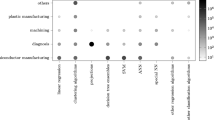Abstract
Purchasing the correct machine tool can have strategic implications for manufacturers, because incorrect selection will eventually lead to quality and productivity losses. Prior research has concentrated on developing an analytical decision support system to select and compare machine tools based on machine functionality—not capability. Machine tool selection decision analyses concentrate on machine specifications and characteristics, which disregard the actual machine accuracy and dynamic performance. In this paper, the need to include machine accuracy and performance in terms of cycle time, tool wear, and surface finish is described with a case study of manufacturing a typical aerospace component using three different production methodologies on three computer numeric controller milling machines. Even though the three selected machine tools have similar technical specifications, which are adequate to manufacture the sample aerospace part, the machine accuracy and dynamic machining performance of the machines is significantly different. We conclude that it is necessary to include machine tool performance and production readiness attributes and not solely rely on the specifications when considering machine tool selection and purchasing.
Similar content being viewed by others
References
Ervin, J Patrick, Look at Machine Capability Before Buying, Manufacturing Engineering, Sep 2004
Zeki Ayag, Ozdemir RG (2006) A fuzzy AHP approach to evaluating machine tool alternatives. J Intell Manuf 17(2):179–190
Moon C, Lee M, Seo Y, Lee Y (2002) Integrated machine tool selection and operation sequencing with capacity and precedence constraints using genetic algorithm. Comput Ind Eng 43(3):605–621
Haddock J, Hartshorn T (1989) A decision support system for specific machine selection. Comput Ind Eng 16(2):277–286
Peng Q (2004) The selection of tools and machines on web-based manufacturing environments. Int J Mach Tool Manuf 44(2–3):317–326
Deshpande A, Snyder J, Scherrer D, Feature level energy assessments for discrete part manufacturing, 39th Annual SME North American Manufacturing Research Conference (NAMRC), June 13–17, 2011—Oregon State University—Corvallis, OR
Atmani A, Lashkari R (1998) A model of machine-tool selection and operation allocation in flexible manufacturing system. Int J Prod Res 36(5):1339–1349
Çimren E, Çatay B, Budak E (2007) Development of a machine tool selection system using AHP. Int J Adv Manuf Technol 35:363–376
Mustafa Y (2004) AHP as a strategic decision-making tool to justify machine tool selection. J Mater Process Technol 146(3):365–376
Semih O, Kara S, Efendigil T (2008) A hybrid fuzzy MCDM approach to machine tool selection. J Intell Manuf 19(4):443–453
MTConnect Institute, MTConnect® Standard: Part 1—overview and protocol, version 1.1.0—final. April 2010
Author information
Authors and Affiliations
Corresponding author
Rights and permissions
About this article
Cite this article
Deshpande, A. An empirical study to evaluate machine tool production readiness and performance. Int J Adv Manuf Technol 64, 1285–1296 (2013). https://doi.org/10.1007/s00170-012-4086-3
Received:
Accepted:
Published:
Issue Date:
DOI: https://doi.org/10.1007/s00170-012-4086-3




